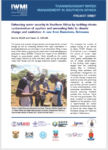
Enhancing resilience through managed aquifer recharge in the Tuli Karoo Transboundary Aquifer Area: What is the potential?
The Tuli Karoo Transboundary Aquifer Area (12,294 km²) – shared by Botswana, South Africa and Zimbabwe – is home to more than 120,000 people that utilize water for domestic needs, agriculture and mining. However, water availability for these uses is severely constrained by low rainfall, high evaporation and significant rainfall…

Agricultural water and nutrient management solutions to support smallholder irrigation schemes: Lessons from the Ramotswa Transboundary Aquifer Area, Limpopo River Basin
Rural agricultural development has great potential to alleviate poverty, reduce food insecurity, and improve rural livelihoods and climate resilience in Africa. Despite the small area under irrigation, the value of irrigated agriculture in sub-Saharan Africa comprises about 25% of total agricultural output. Due to the significant amount of water used…

Project Brief: Groundwater Monitoring in the Tuli Karoo Transboundary Aquifer Area
At present, Botswana and South Africa undertake some monitoring within the Tuli Karoo Transboundary Aquifer Area for their own purposes; Zimbabwe (covering about 57% of the area) does not actively monitor the aquifer. Therefore, an aim of the Conjunctive Water Resources Management across Borders in the Southern African Development Community…

Project Brief: A first step toward integrated management: Transboundary Diagnostic Analysis of the shared Tuli Karoo System, Limpopo River Basin
The Tuli Karoo Aquifer Area — as well as the broader surface water system that encompasses the aquifer — is shared among Botswana, South Africa and Zimbabwe, and forms part of the Limpopo River Basin. There has been very little investigation into the Tuli Karoo aquifer or the associated surface…

Project Brief: Joint Strategic Action Plan for the Ramotswa Transboundary Aquifer Area
Cooperative development and management of shared waters is widely recognized for its role in enhancing water security and increasing resilience. Protocols under the United Nations and the Southern African Development Community (SADC) call for cooperation on transboundary waters. Also, Target 6.5 under Goal 6 of the United Nations Sustainable Development…

Project Brief: Enhancing water security in Southern Africa by tackling nitrate contamination of aquifers and unraveling links to climate change and sanitation: A case from Ramotswa, Botswana
The quality and quantity of groundwater are threatened by climate change as well as increasing demand from rapid urbanization in southeast Botswana, as is the case in much of southern Africa. A case study of Ramotswa, a growing peri-urban area in southeast Botswana (population about 40,000), revealed the impact of the 2013-2016 drought on groundwater quality. Water shutoffs by the public water supply scheme to ration and save water during the drought made flush toilets and the sewage treatment system inoperable.

Policy Brief: Considering social and gender aspects in transboundary assessments and cooperation
Cooperation is important in transboundary groundwater management. Actions in the utilization of aquifers on one side of the border can have negative impacts upon a neighboring state’s overall access, and consequently their delivery on national social and gender equity goals. In turn, cooperation on shared groundwater can offset conflicts and enhance joint benefits of the aquifers. International instruments increasingly emphasize gender and social factors, but transboundary arrangements and practices regarding shared aquifers continue to fail to address these issues. This may jeopardize water security and livelihood options for small communities in the border regions, enhancing risks to social cohesions, livelihoods and wellbeing.







